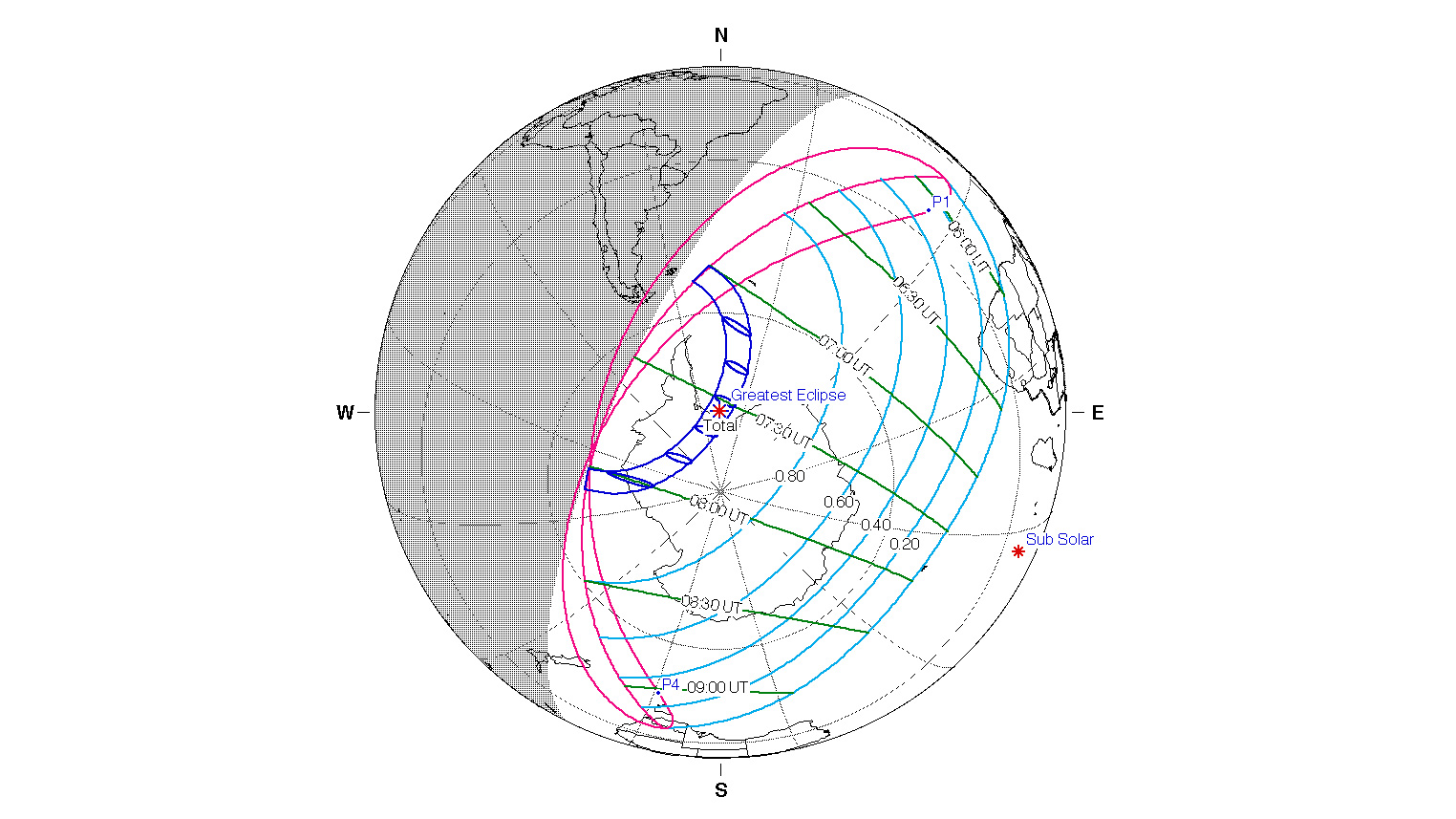What time is the total solar eclipse on Dec. 4?
The big problem might not be time zone, but accessibility of the prime Antarctic site.
Update for Dec. 4, 2021: The total solar eclipse of Dec. 4 has ended over Antarctica. You can see a video above and see photos and our full wrap story here.
If you're ready to catch the only total solar eclipse of 2021 on Saturday (Dec. 4), you likely are either a research scientist, a well-heeled tourist or a penguin.
That's because the prime location for the total phase is in Antarctica, although there may be a livestream available. The partial phase starts at 2 a.m. EST (0700 GMT), the nearly two-minute totality phase — when the moon completely blocks out the sun — starts at 2:33 a.m. EST (0733 GMT), and the whole eclipse ends at 3:06 a.m. (0806 GMT), according to NASA.
If you can't make it there in person, weather permitting, NASA plans to broadcast the total solar eclipse from Union Glacier, Antarctica on YouTube and nasa.gov/live. The stream starts at 1:30 a.m. EST (0630 GMT), totality begins at 2:44 a.m. EST (0744 GMT) and the stream ends at 3:37 a.m. EST (0837 GMT).
If you live in the a region where the solar eclipse may be visible, here's our guide on how to photograph a solar eclipse safely. Check out our guide for the best cameras for astrophotography and the best lenses for astrophotography to prepare for the next solar eclipse.
Related: Total solar eclipse 2021: When, where and how to see it on Dec. 4
Antarctica happened to be the region best positioned this time for the solar eclipse, as the new moon passes across the sun and throws a very small shadow on the face of the Earth.
Get the Space.com Newsletter
Breaking space news, the latest updates on rocket launches, skywatching events and more!
Some of the luckiest humans to see the total eclipse include the estimated summertime population of 40 at the National Science Foundation's Antarctic Palmer Station, or tourists who caught scheduled eclipse flights at a price of thousands of dollars a seat.
The partial phase of the eclipse will be visible from the southernmost regions within Australia, New Zealand, Argentina and South Africa, according to an interactive map from Time and Date.
| Location | Partial eclipse begins | Maximum eclipse | Partial eclipse ends | % of sun covered |
|---|---|---|---|---|
| Palmer Station, Antarctica | 3:34 a.m. | 4:23 a.m. | 5:12 a.m. | 94% |
| Emperor Point, Antarctica | 3:42 a.m. | 4:35 a.m. | 5:28 a.m. | 100% |
| Melbourne, Australia | 7:53 p.m. | 8:12 p.m. | below the horizon | 2% |
| Cape Town, South Africa | 7:42 a.m. | 8:19 a.m. | 8:58 a.m. | 12% |
| Cabo Kempe, Argentina | below the horizon | 4:42 a.m. | 4:59 a.m. | 25% |
If you happen to be within reach of the eclipse, either partial or total, make sure to use precautions to safely observe the sun. You will need special protective eyewear or certified eclipse glasses. Eyeglasses will not protect you, even with UV protection. The safest way to observe an eclipse is indirectly, using a pinhole camera that you can make easily at home.
If you can't catch this eclipse in person or online, your next opportunity is April 20, 2023. That total eclipse will pass over southern and eastern Asia, according to NASA's eclipse site.

Editor's Note: If you snap an amazing solar eclipse photo and would like to share it with Space.com's readers, send your photo(s), comments, and your name and location to spacephotos@space.com.
Follow Elizabeth Howell on Twitter @howellspace. Follow us on Twitter @Spacedotcom and on Facebook.
Join our Space Forums to keep talking space on the latest missions, night sky and more! And if you have a news tip, correction or comment, let us know at: community@space.com.

Elizabeth Howell (she/her), Ph.D., was a staff writer in the spaceflight channel between 2022 and 2024 specializing in Canadian space news. She was contributing writer for Space.com for 10 years from 2012 to 2024. Elizabeth's reporting includes multiple exclusives with the White House, leading world coverage about a lost-and-found space tomato on the International Space Station, witnessing five human spaceflight launches on two continents, flying parabolic, working inside a spacesuit, and participating in a simulated Mars mission. Her latest book, "Why Am I Taller?" (ECW Press, 2022) is co-written with astronaut Dave Williams.









